Developing Leadership for Health Promotion: Models and Strategies
VerifiedAdded on 2023/01/09
|8
|2082
|41
Essay
AI Summary
This essay provides a comprehensive overview of leadership and change management within the context of health promotion. It begins by defining leadership and change, highlighting their interconnectedness and importance. The main body delves into various leadership styles, including situational and contingency leadership, analyzing their strengths and weaknesses and providing relevant examples within the healthcare sector. Furthermore, the essay explores organizational change models, specifically the Lewin change model and Kotter's 8-step model, outlining their stages, strengths, and weaknesses. The role of leadership in driving change within health programs is emphasized, with a focus on how leaders utilize these models and strategies to effectively promote health initiatives. The essay concludes by reiterating the significance of leadership in implementing successful change and achieving health-related goals.
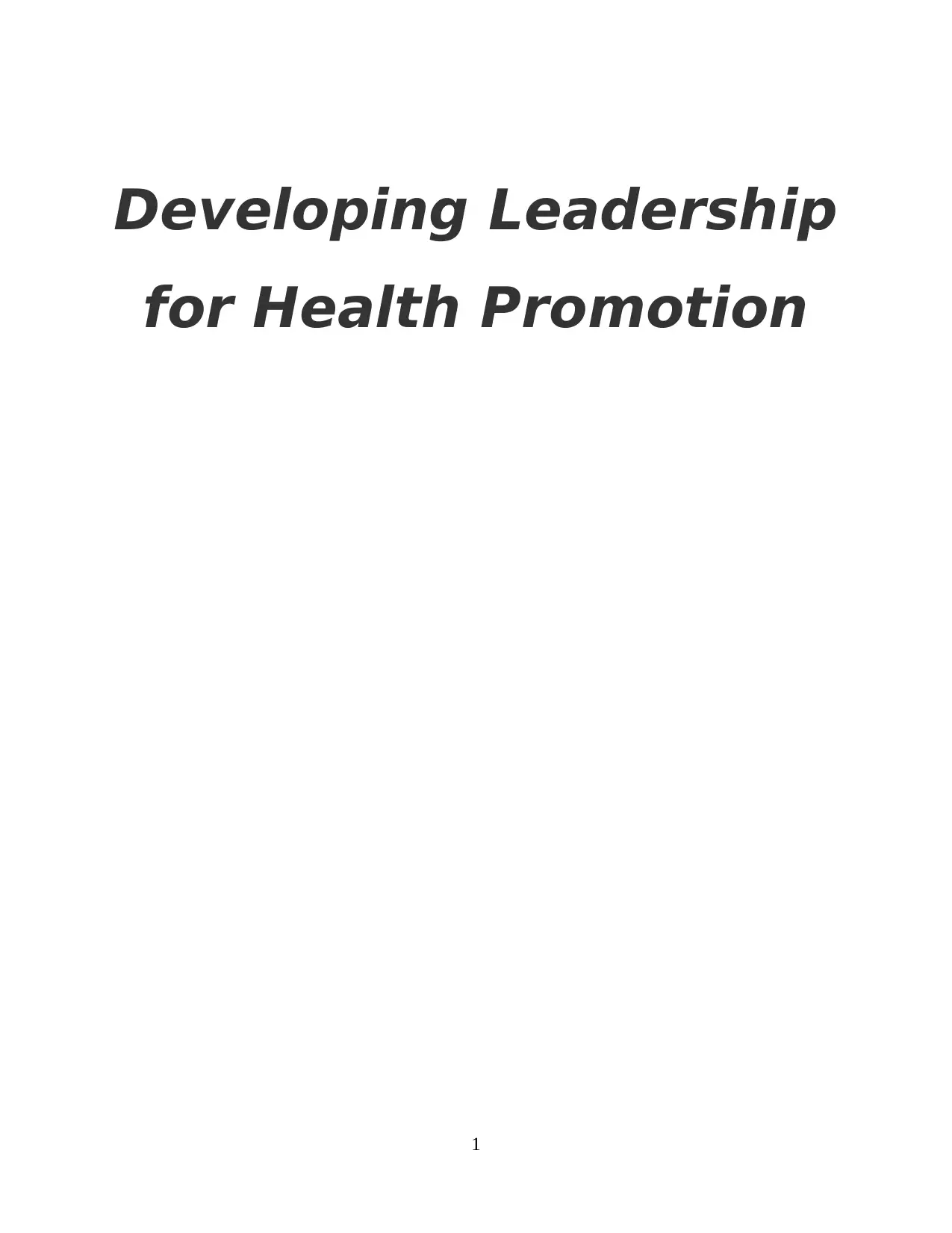
Developing Leadership
for Health Promotion
1
for Health Promotion
1
Paraphrase This Document
Need a fresh take? Get an instant paraphrase of this document with our AI Paraphraser
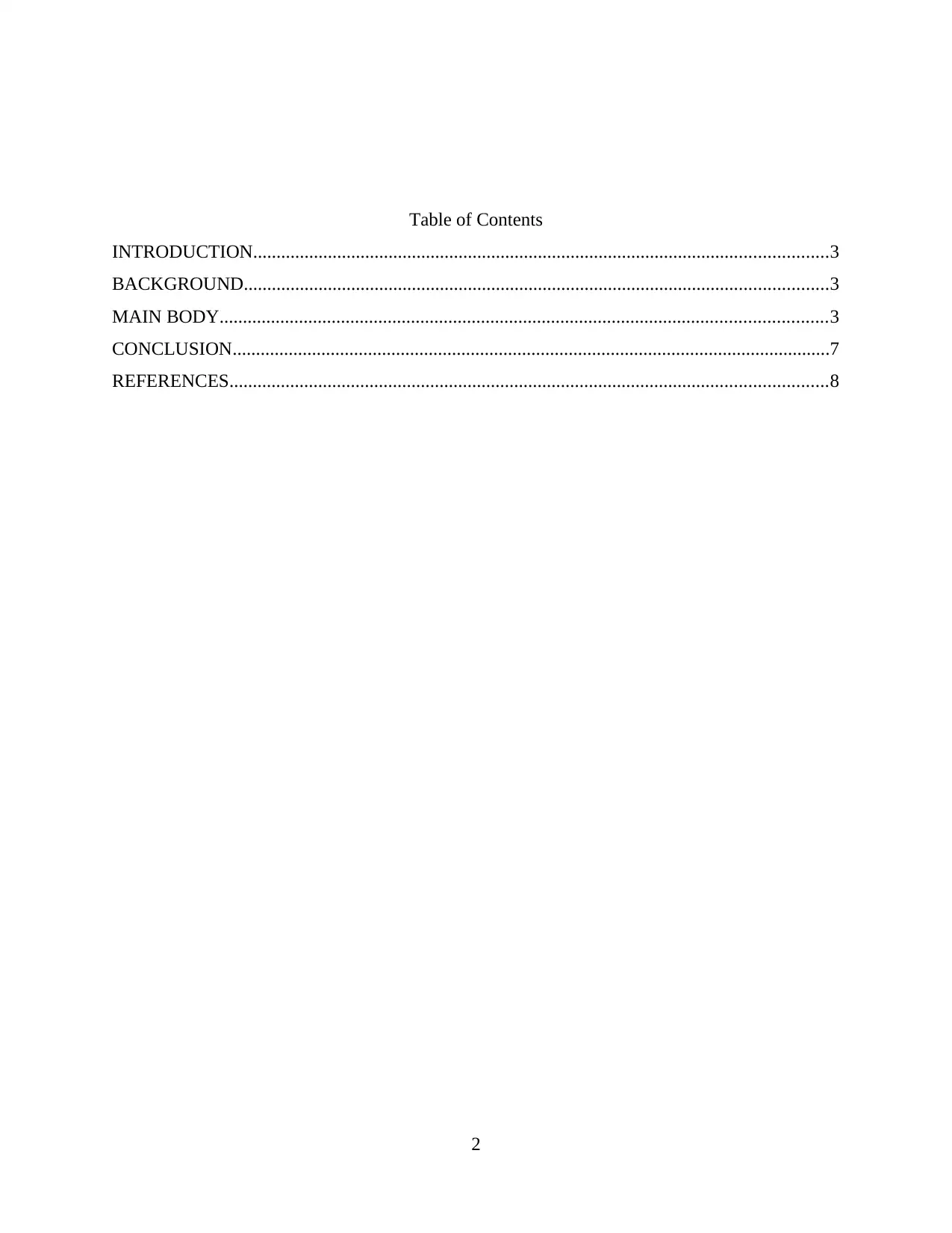
Table of Contents
INTRODUCTION...........................................................................................................................3
BACKGROUND.............................................................................................................................3
MAIN BODY..................................................................................................................................3
CONCLUSION................................................................................................................................7
REFERENCES................................................................................................................................8
2
INTRODUCTION...........................................................................................................................3
BACKGROUND.............................................................................................................................3
MAIN BODY..................................................................................................................................3
CONCLUSION................................................................................................................................7
REFERENCES................................................................................................................................8
2
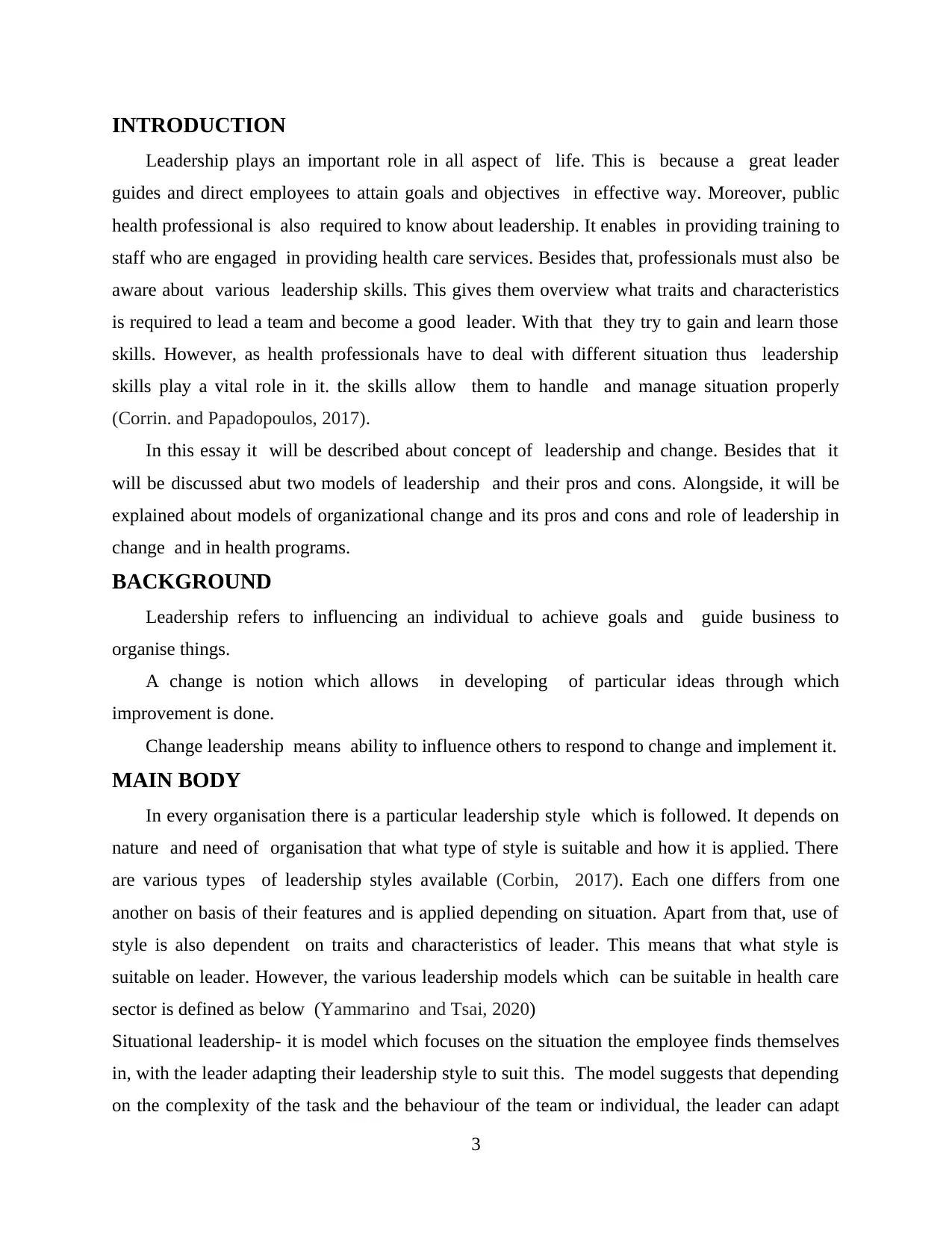
INTRODUCTION
Leadership plays an important role in all aspect of life. This is because a great leader
guides and direct employees to attain goals and objectives in effective way. Moreover, public
health professional is also required to know about leadership. It enables in providing training to
staff who are engaged in providing health care services. Besides that, professionals must also be
aware about various leadership skills. This gives them overview what traits and characteristics
is required to lead a team and become a good leader. With that they try to gain and learn those
skills. However, as health professionals have to deal with different situation thus leadership
skills play a vital role in it. the skills allow them to handle and manage situation properly
(Corrin. and Papadopoulos, 2017).
In this essay it will be described about concept of leadership and change. Besides that it
will be discussed abut two models of leadership and their pros and cons. Alongside, it will be
explained about models of organizational change and its pros and cons and role of leadership in
change and in health programs.
BACKGROUND
Leadership refers to influencing an individual to achieve goals and guide business to
organise things.
A change is notion which allows in developing of particular ideas through which
improvement is done.
Change leadership means ability to influence others to respond to change and implement it.
MAIN BODY
In every organisation there is a particular leadership style which is followed. It depends on
nature and need of organisation that what type of style is suitable and how it is applied. There
are various types of leadership styles available (Corbin, 2017). Each one differs from one
another on basis of their features and is applied depending on situation. Apart from that, use of
style is also dependent on traits and characteristics of leader. This means that what style is
suitable on leader. However, the various leadership models which can be suitable in health care
sector is defined as below (Yammarino and Tsai, 2020)
Situational leadership- it is model which focuses on the situation the employee finds themselves
in, with the leader adapting their leadership style to suit this. The model suggests that depending
on the complexity of the task and the behaviour of the team or individual, the leader can adapt
3
Leadership plays an important role in all aspect of life. This is because a great leader
guides and direct employees to attain goals and objectives in effective way. Moreover, public
health professional is also required to know about leadership. It enables in providing training to
staff who are engaged in providing health care services. Besides that, professionals must also be
aware about various leadership skills. This gives them overview what traits and characteristics
is required to lead a team and become a good leader. With that they try to gain and learn those
skills. However, as health professionals have to deal with different situation thus leadership
skills play a vital role in it. the skills allow them to handle and manage situation properly
(Corrin. and Papadopoulos, 2017).
In this essay it will be described about concept of leadership and change. Besides that it
will be discussed abut two models of leadership and their pros and cons. Alongside, it will be
explained about models of organizational change and its pros and cons and role of leadership in
change and in health programs.
BACKGROUND
Leadership refers to influencing an individual to achieve goals and guide business to
organise things.
A change is notion which allows in developing of particular ideas through which
improvement is done.
Change leadership means ability to influence others to respond to change and implement it.
MAIN BODY
In every organisation there is a particular leadership style which is followed. It depends on
nature and need of organisation that what type of style is suitable and how it is applied. There
are various types of leadership styles available (Corbin, 2017). Each one differs from one
another on basis of their features and is applied depending on situation. Apart from that, use of
style is also dependent on traits and characteristics of leader. This means that what style is
suitable on leader. However, the various leadership models which can be suitable in health care
sector is defined as below (Yammarino and Tsai, 2020)
Situational leadership- it is model which focuses on the situation the employee finds themselves
in, with the leader adapting their leadership style to suit this. The model suggests that depending
on the complexity of the task and the behaviour of the team or individual, the leader can adapt
3
⊘ This is a preview!⊘
Do you want full access?
Subscribe today to unlock all pages.

Trusted by 1+ million students worldwide
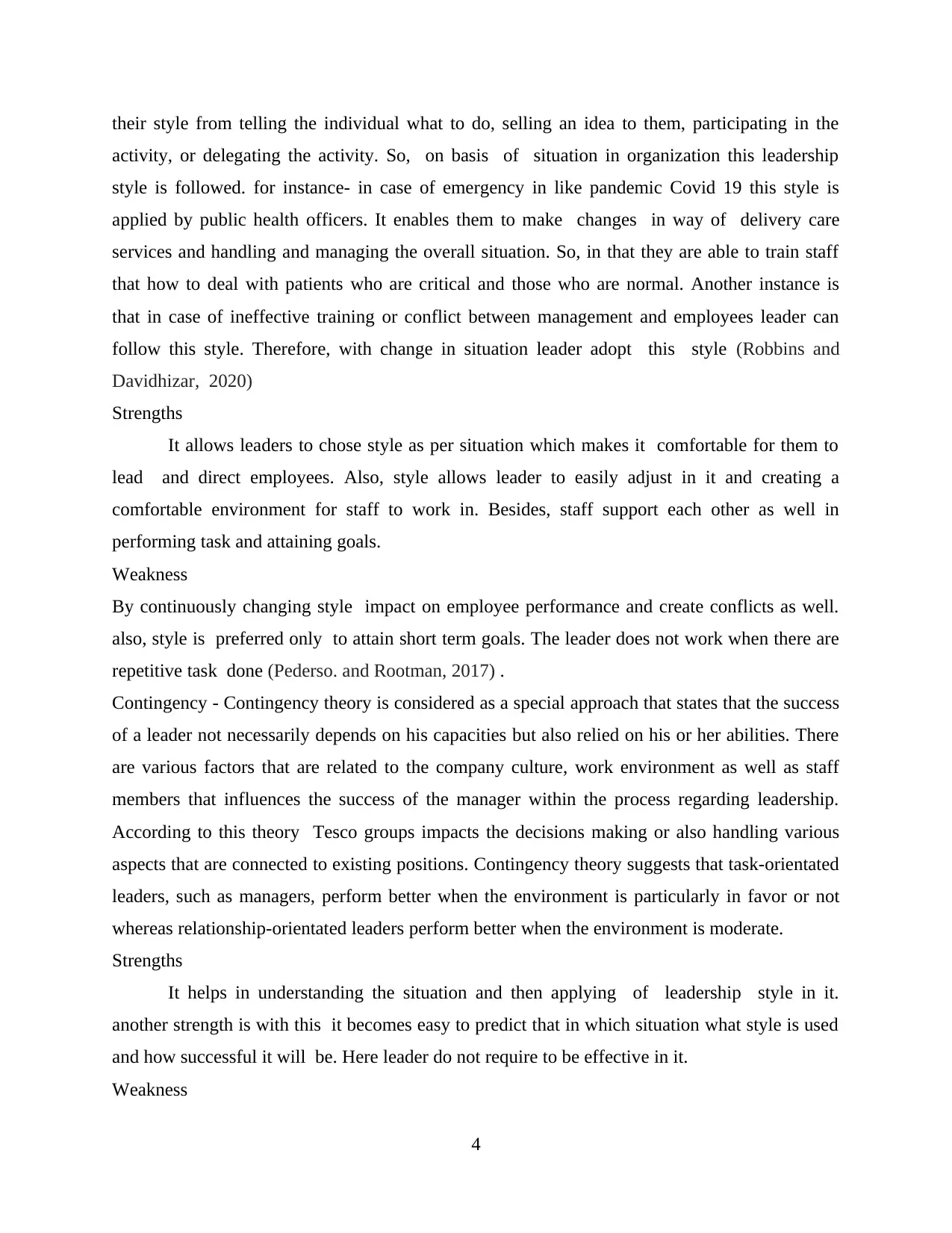
their style from telling the individual what to do, selling an idea to them, participating in the
activity, or delegating the activity. So, on basis of situation in organization this leadership
style is followed. for instance- in case of emergency in like pandemic Covid 19 this style is
applied by public health officers. It enables them to make changes in way of delivery care
services and handling and managing the overall situation. So, in that they are able to train staff
that how to deal with patients who are critical and those who are normal. Another instance is
that in case of ineffective training or conflict between management and employees leader can
follow this style. Therefore, with change in situation leader adopt this style (Robbins and
Davidhizar, 2020)
Strengths
It allows leaders to chose style as per situation which makes it comfortable for them to
lead and direct employees. Also, style allows leader to easily adjust in it and creating a
comfortable environment for staff to work in. Besides, staff support each other as well in
performing task and attaining goals.
Weakness
By continuously changing style impact on employee performance and create conflicts as well.
also, style is preferred only to attain short term goals. The leader does not work when there are
repetitive task done (Pederso. and Rootman, 2017) .
Contingency - Contingency theory is considered as a special approach that states that the success
of a leader not necessarily depends on his capacities but also relied on his or her abilities. There
are various factors that are related to the company culture, work environment as well as staff
members that influences the success of the manager within the process regarding leadership.
According to this theory Tesco groups impacts the decisions making or also handling various
aspects that are connected to existing positions. Contingency theory suggests that task-orientated
leaders, such as managers, perform better when the environment is particularly in favor or not
whereas relationship-orientated leaders perform better when the environment is moderate.
Strengths
It helps in understanding the situation and then applying of leadership style in it.
another strength is with this it becomes easy to predict that in which situation what style is used
and how successful it will be. Here leader do not require to be effective in it.
Weakness
4
activity, or delegating the activity. So, on basis of situation in organization this leadership
style is followed. for instance- in case of emergency in like pandemic Covid 19 this style is
applied by public health officers. It enables them to make changes in way of delivery care
services and handling and managing the overall situation. So, in that they are able to train staff
that how to deal with patients who are critical and those who are normal. Another instance is
that in case of ineffective training or conflict between management and employees leader can
follow this style. Therefore, with change in situation leader adopt this style (Robbins and
Davidhizar, 2020)
Strengths
It allows leaders to chose style as per situation which makes it comfortable for them to
lead and direct employees. Also, style allows leader to easily adjust in it and creating a
comfortable environment for staff to work in. Besides, staff support each other as well in
performing task and attaining goals.
Weakness
By continuously changing style impact on employee performance and create conflicts as well.
also, style is preferred only to attain short term goals. The leader does not work when there are
repetitive task done (Pederso. and Rootman, 2017) .
Contingency - Contingency theory is considered as a special approach that states that the success
of a leader not necessarily depends on his capacities but also relied on his or her abilities. There
are various factors that are related to the company culture, work environment as well as staff
members that influences the success of the manager within the process regarding leadership.
According to this theory Tesco groups impacts the decisions making or also handling various
aspects that are connected to existing positions. Contingency theory suggests that task-orientated
leaders, such as managers, perform better when the environment is particularly in favor or not
whereas relationship-orientated leaders perform better when the environment is moderate.
Strengths
It helps in understanding the situation and then applying of leadership style in it.
another strength is with this it becomes easy to predict that in which situation what style is used
and how successful it will be. Here leader do not require to be effective in it.
Weakness
4
Paraphrase This Document
Need a fresh take? Get an instant paraphrase of this document with our AI Paraphraser
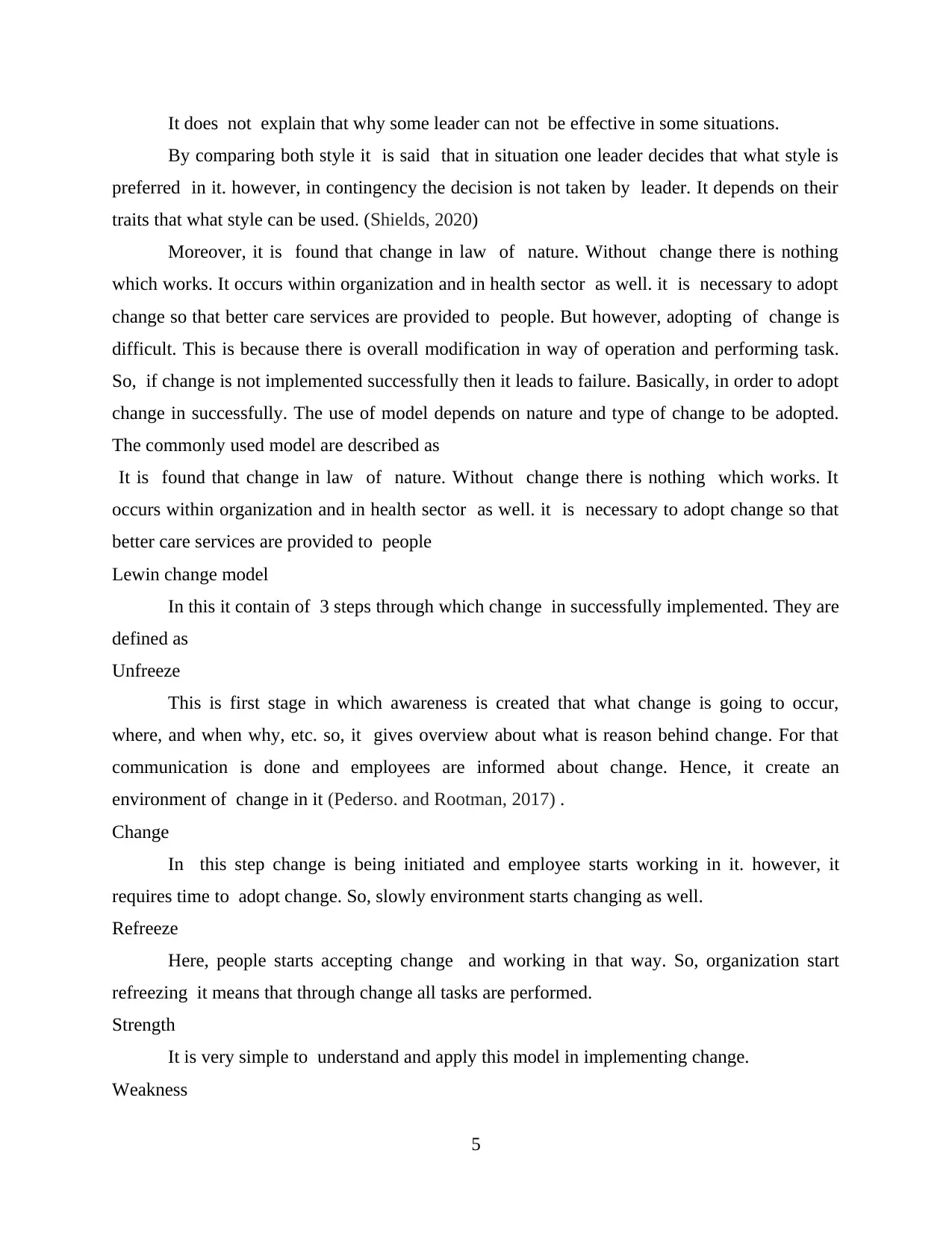
It does not explain that why some leader can not be effective in some situations.
By comparing both style it is said that in situation one leader decides that what style is
preferred in it. however, in contingency the decision is not taken by leader. It depends on their
traits that what style can be used. (Shields, 2020)
Moreover, it is found that change in law of nature. Without change there is nothing
which works. It occurs within organization and in health sector as well. it is necessary to adopt
change so that better care services are provided to people. But however, adopting of change is
difficult. This is because there is overall modification in way of operation and performing task.
So, if change is not implemented successfully then it leads to failure. Basically, in order to adopt
change in successfully. The use of model depends on nature and type of change to be adopted.
The commonly used model are described as
It is found that change in law of nature. Without change there is nothing which works. It
occurs within organization and in health sector as well. it is necessary to adopt change so that
better care services are provided to people
Lewin change model
In this it contain of 3 steps through which change in successfully implemented. They are
defined as
Unfreeze
This is first stage in which awareness is created that what change is going to occur,
where, and when why, etc. so, it gives overview about what is reason behind change. For that
communication is done and employees are informed about change. Hence, it create an
environment of change in it (Pederso. and Rootman, 2017) .
Change
In this step change is being initiated and employee starts working in it. however, it
requires time to adopt change. So, slowly environment starts changing as well.
Refreeze
Here, people starts accepting change and working in that way. So, organization start
refreezing it means that through change all tasks are performed.
Strength
It is very simple to understand and apply this model in implementing change.
Weakness
5
By comparing both style it is said that in situation one leader decides that what style is
preferred in it. however, in contingency the decision is not taken by leader. It depends on their
traits that what style can be used. (Shields, 2020)
Moreover, it is found that change in law of nature. Without change there is nothing
which works. It occurs within organization and in health sector as well. it is necessary to adopt
change so that better care services are provided to people. But however, adopting of change is
difficult. This is because there is overall modification in way of operation and performing task.
So, if change is not implemented successfully then it leads to failure. Basically, in order to adopt
change in successfully. The use of model depends on nature and type of change to be adopted.
The commonly used model are described as
It is found that change in law of nature. Without change there is nothing which works. It
occurs within organization and in health sector as well. it is necessary to adopt change so that
better care services are provided to people
Lewin change model
In this it contain of 3 steps through which change in successfully implemented. They are
defined as
Unfreeze
This is first stage in which awareness is created that what change is going to occur,
where, and when why, etc. so, it gives overview about what is reason behind change. For that
communication is done and employees are informed about change. Hence, it create an
environment of change in it (Pederso. and Rootman, 2017) .
Change
In this step change is being initiated and employee starts working in it. however, it
requires time to adopt change. So, slowly environment starts changing as well.
Refreeze
Here, people starts accepting change and working in that way. So, organization start
refreezing it means that through change all tasks are performed.
Strength
It is very simple to understand and apply this model in implementing change.
Weakness
5
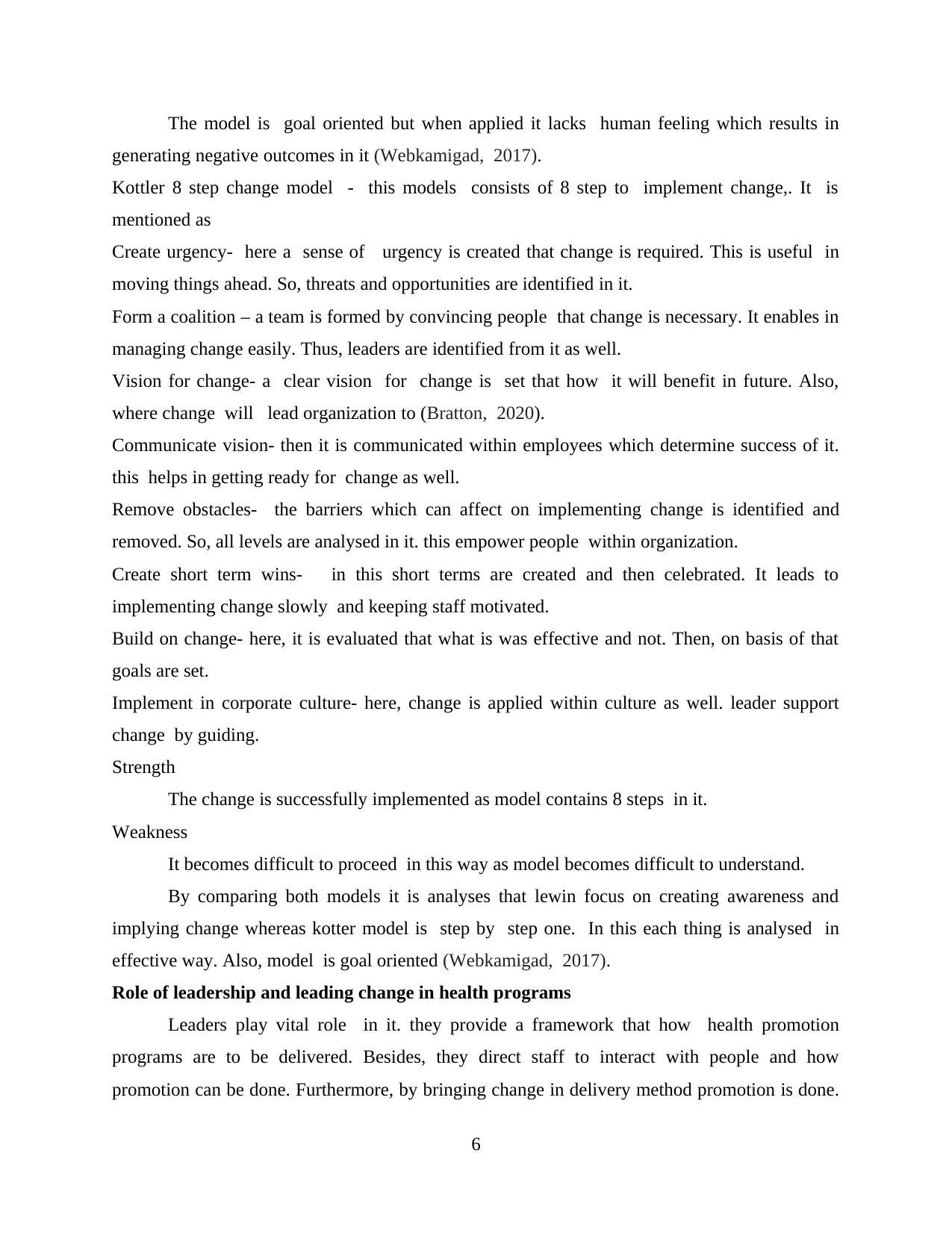
The model is goal oriented but when applied it lacks human feeling which results in
generating negative outcomes in it (Webkamigad, 2017).
Kottler 8 step change model - this models consists of 8 step to implement change,. It is
mentioned as
Create urgency- here a sense of urgency is created that change is required. This is useful in
moving things ahead. So, threats and opportunities are identified in it.
Form a coalition – a team is formed by convincing people that change is necessary. It enables in
managing change easily. Thus, leaders are identified from it as well.
Vision for change- a clear vision for change is set that how it will benefit in future. Also,
where change will lead organization to (Bratton, 2020).
Communicate vision- then it is communicated within employees which determine success of it.
this helps in getting ready for change as well.
Remove obstacles- the barriers which can affect on implementing change is identified and
removed. So, all levels are analysed in it. this empower people within organization.
Create short term wins- in this short terms are created and then celebrated. It leads to
implementing change slowly and keeping staff motivated.
Build on change- here, it is evaluated that what is was effective and not. Then, on basis of that
goals are set.
Implement in corporate culture- here, change is applied within culture as well. leader support
change by guiding.
Strength
The change is successfully implemented as model contains 8 steps in it.
Weakness
It becomes difficult to proceed in this way as model becomes difficult to understand.
By comparing both models it is analyses that lewin focus on creating awareness and
implying change whereas kotter model is step by step one. In this each thing is analysed in
effective way. Also, model is goal oriented (Webkamigad, 2017).
Role of leadership and leading change in health programs
Leaders play vital role in it. they provide a framework that how health promotion
programs are to be delivered. Besides, they direct staff to interact with people and how
promotion can be done. Furthermore, by bringing change in delivery method promotion is done.
6
generating negative outcomes in it (Webkamigad, 2017).
Kottler 8 step change model - this models consists of 8 step to implement change,. It is
mentioned as
Create urgency- here a sense of urgency is created that change is required. This is useful in
moving things ahead. So, threats and opportunities are identified in it.
Form a coalition – a team is formed by convincing people that change is necessary. It enables in
managing change easily. Thus, leaders are identified from it as well.
Vision for change- a clear vision for change is set that how it will benefit in future. Also,
where change will lead organization to (Bratton, 2020).
Communicate vision- then it is communicated within employees which determine success of it.
this helps in getting ready for change as well.
Remove obstacles- the barriers which can affect on implementing change is identified and
removed. So, all levels are analysed in it. this empower people within organization.
Create short term wins- in this short terms are created and then celebrated. It leads to
implementing change slowly and keeping staff motivated.
Build on change- here, it is evaluated that what is was effective and not. Then, on basis of that
goals are set.
Implement in corporate culture- here, change is applied within culture as well. leader support
change by guiding.
Strength
The change is successfully implemented as model contains 8 steps in it.
Weakness
It becomes difficult to proceed in this way as model becomes difficult to understand.
By comparing both models it is analyses that lewin focus on creating awareness and
implying change whereas kotter model is step by step one. In this each thing is analysed in
effective way. Also, model is goal oriented (Webkamigad, 2017).
Role of leadership and leading change in health programs
Leaders play vital role in it. they provide a framework that how health promotion
programs are to be delivered. Besides, they direct staff to interact with people and how
promotion can be done. Furthermore, by bringing change in delivery method promotion is done.
6
⊘ This is a preview!⊘
Do you want full access?
Subscribe today to unlock all pages.

Trusted by 1+ million students worldwide
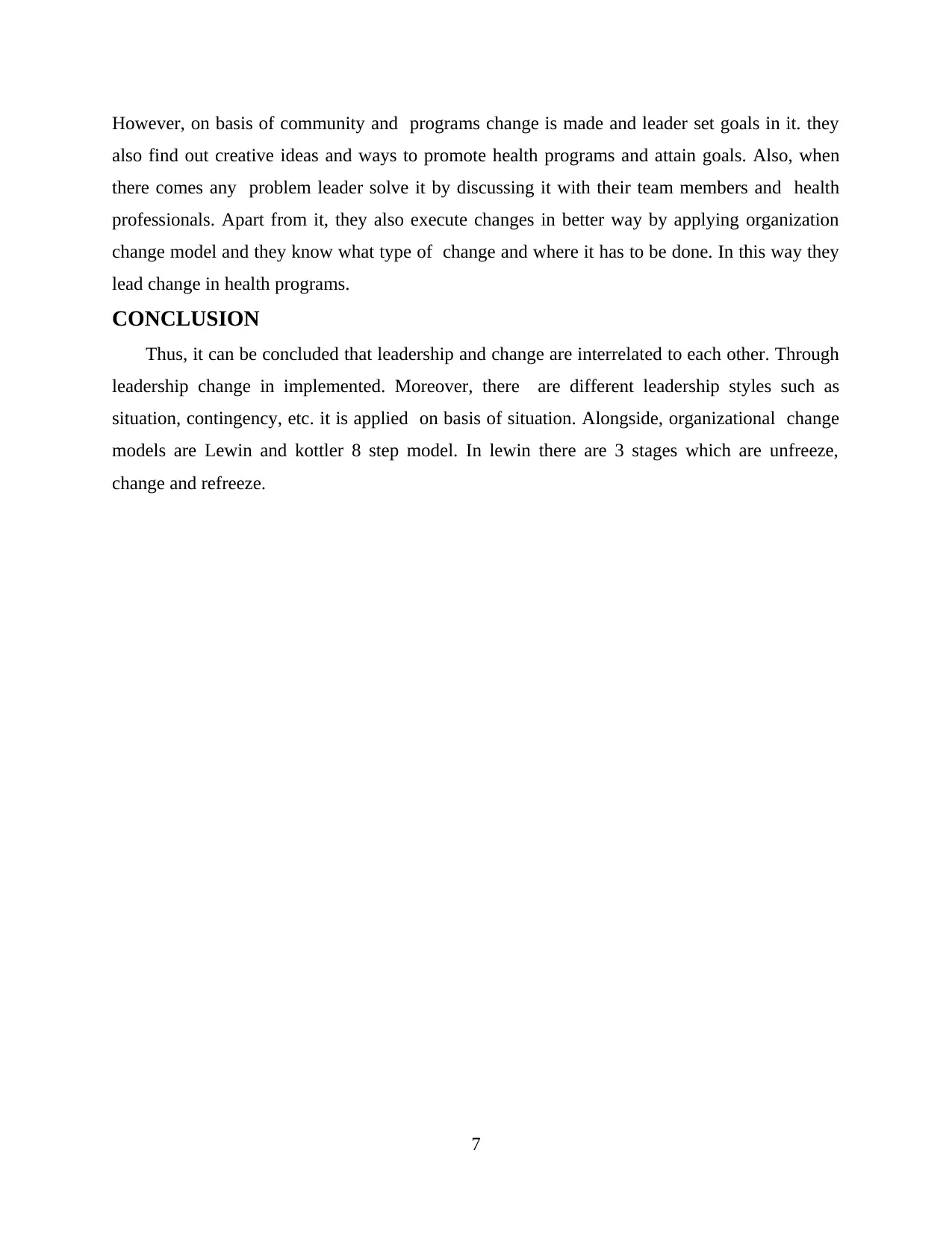
However, on basis of community and programs change is made and leader set goals in it. they
also find out creative ideas and ways to promote health programs and attain goals. Also, when
there comes any problem leader solve it by discussing it with their team members and health
professionals. Apart from it, they also execute changes in better way by applying organization
change model and they know what type of change and where it has to be done. In this way they
lead change in health programs.
CONCLUSION
Thus, it can be concluded that leadership and change are interrelated to each other. Through
leadership change in implemented. Moreover, there are different leadership styles such as
situation, contingency, etc. it is applied on basis of situation. Alongside, organizational change
models are Lewin and kottler 8 step model. In lewin there are 3 stages which are unfreeze,
change and refreeze.
7
also find out creative ideas and ways to promote health programs and attain goals. Also, when
there comes any problem leader solve it by discussing it with their team members and health
professionals. Apart from it, they also execute changes in better way by applying organization
change model and they know what type of change and where it has to be done. In this way they
lead change in health programs.
CONCLUSION
Thus, it can be concluded that leadership and change are interrelated to each other. Through
leadership change in implemented. Moreover, there are different leadership styles such as
situation, contingency, etc. it is applied on basis of situation. Alongside, organizational change
models are Lewin and kottler 8 step model. In lewin there are 3 stages which are unfreeze,
change and refreeze.
7
Paraphrase This Document
Need a fresh take? Get an instant paraphrase of this document with our AI Paraphraser
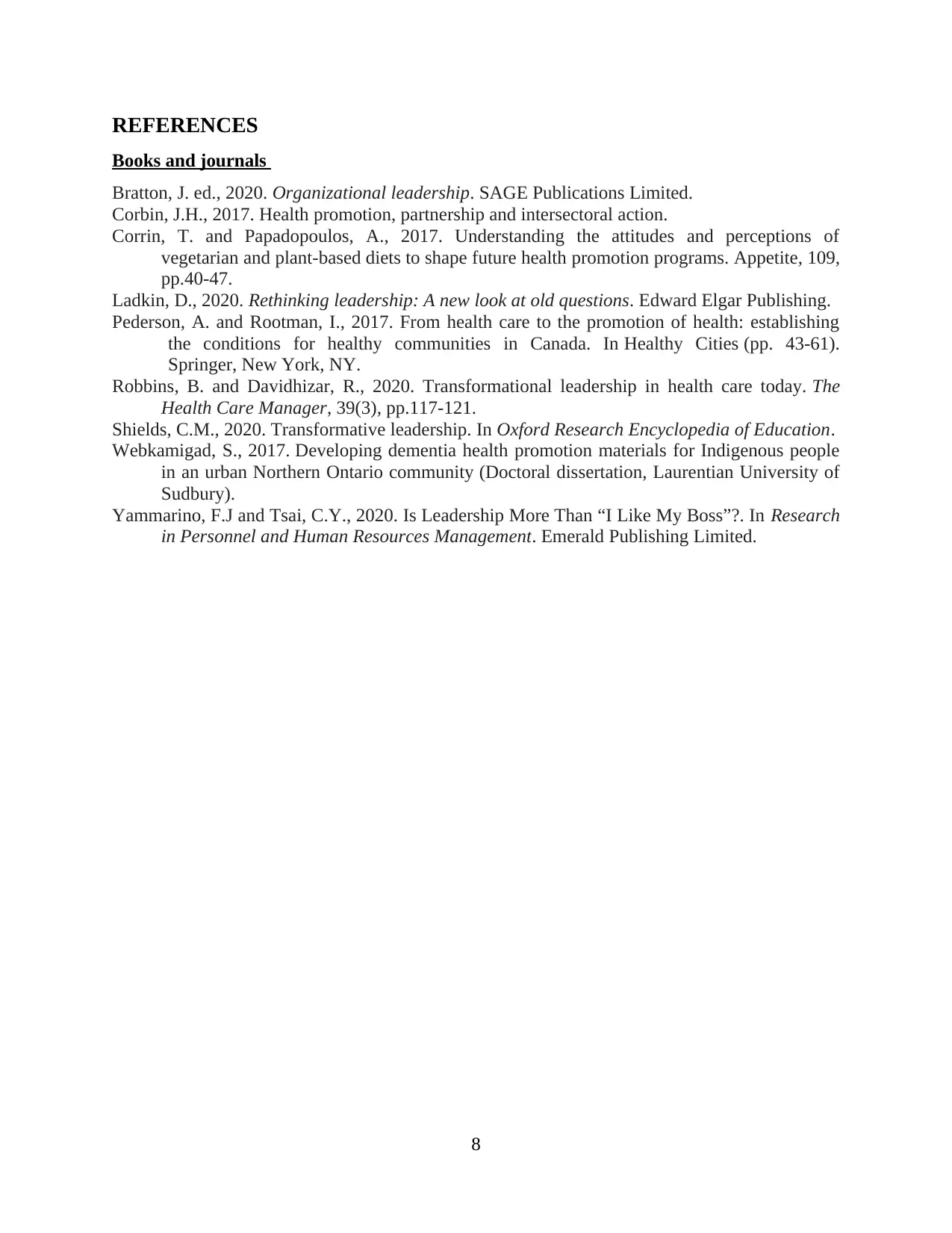
REFERENCES
Books and journals
Bratton, J. ed., 2020. Organizational leadership. SAGE Publications Limited.
Corbin, J.H., 2017. Health promotion, partnership and intersectoral action.
Corrin, T. and Papadopoulos, A., 2017. Understanding the attitudes and perceptions of
vegetarian and plant-based diets to shape future health promotion programs. Appetite, 109,
pp.40-47.
Ladkin, D., 2020. Rethinking leadership: A new look at old questions. Edward Elgar Publishing.
Pederson, A. and Rootman, I., 2017. From health care to the promotion of health: establishing
the conditions for healthy communities in Canada. In Healthy Cities (pp. 43-61).
Springer, New York, NY.
Robbins, B. and Davidhizar, R., 2020. Transformational leadership in health care today. The
Health Care Manager, 39(3), pp.117-121.
Shields, C.M., 2020. Transformative leadership. In Oxford Research Encyclopedia of Education.
Webkamigad, S., 2017. Developing dementia health promotion materials for Indigenous people
in an urban Northern Ontario community (Doctoral dissertation, Laurentian University of
Sudbury).
Yammarino, F.J and Tsai, C.Y., 2020. Is Leadership More Than “I Like My Boss”?. In Research
in Personnel and Human Resources Management. Emerald Publishing Limited.
8
Books and journals
Bratton, J. ed., 2020. Organizational leadership. SAGE Publications Limited.
Corbin, J.H., 2017. Health promotion, partnership and intersectoral action.
Corrin, T. and Papadopoulos, A., 2017. Understanding the attitudes and perceptions of
vegetarian and plant-based diets to shape future health promotion programs. Appetite, 109,
pp.40-47.
Ladkin, D., 2020. Rethinking leadership: A new look at old questions. Edward Elgar Publishing.
Pederson, A. and Rootman, I., 2017. From health care to the promotion of health: establishing
the conditions for healthy communities in Canada. In Healthy Cities (pp. 43-61).
Springer, New York, NY.
Robbins, B. and Davidhizar, R., 2020. Transformational leadership in health care today. The
Health Care Manager, 39(3), pp.117-121.
Shields, C.M., 2020. Transformative leadership. In Oxford Research Encyclopedia of Education.
Webkamigad, S., 2017. Developing dementia health promotion materials for Indigenous people
in an urban Northern Ontario community (Doctoral dissertation, Laurentian University of
Sudbury).
Yammarino, F.J and Tsai, C.Y., 2020. Is Leadership More Than “I Like My Boss”?. In Research
in Personnel and Human Resources Management. Emerald Publishing Limited.
8
1 out of 8
Related Documents
Your All-in-One AI-Powered Toolkit for Academic Success.
+13062052269
info@desklib.com
Available 24*7 on WhatsApp / Email
![[object Object]](/_next/static/media/star-bottom.7253800d.svg)
Unlock your academic potential
Copyright © 2020–2025 A2Z Services. All Rights Reserved. Developed and managed by ZUCOL.





